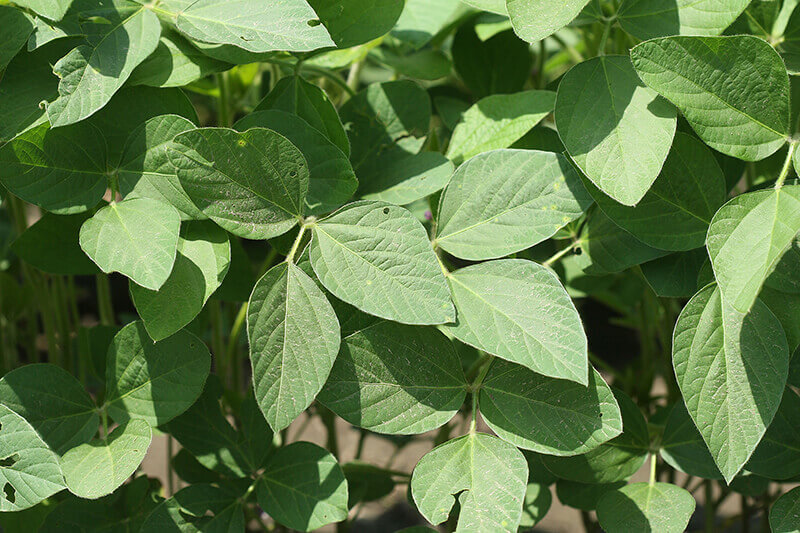January 3, 2018
Study suggests new targets for improving soybean oil content
 Jianxin Ma, Purdue University professor of agronomy, has found that a gene affecting bloom in soybeans also increases the crop’s seed oil content. (Purdue Agricultural Communication photo/Tom Campbell)
Download image
Jianxin Ma, Purdue University professor of agronomy, has found that a gene affecting bloom in soybeans also increases the crop’s seed oil content. (Purdue Agricultural Communication photo/Tom Campbell)
Download image
WEST LAFAYETTE, Ind. - Scientists working to increase soybean oil content tend to focus their efforts on genes known to impact the plant’s seeds, but a Purdue University study shows that genes affecting other plant parts deserve more attention.
Wild-type soybeans contain bloom, a powdery substance originating in the pod that can coat seeds. This trait makes the seeds less visible and is believed to be advantageous for their long-term survival in natural environments. But the bloom is enriched with allergens and can be harmful for animals and people if ingested. People domesticating soybeans selected a naturally occurring mutation that makes soybean seeds shiny through eliminating bloom.
“This mutation was selected by ancient farmers approximately 5,000 years ago,” said Jianxin Ma, professor in Purdue’s Department of Agronomy. “That could have been a key step for domesticating soybean for agricultural production and human consumption.”
Ma and his colleagues wanted to know more about the genetic control of bloom in wild soybeans. They found that a single nucleotide polymorphism - a change from a single cytosine (C) to a thymine (T) within a gene called B1 eliminates bloom from wild soybeans.
Surprisingly, that’s not all the mutation did for soybeans.
“We found that the mutation within the B1 gene resulted in substantial increases of seed oil content in cultivated soybeans compared with the wild type,” said Ma, whose findings were published in the journal Nature Plants. “It seems like the selection of this mutation by farmers was essential for making soybean an important oilseed crop that we have now.”
The B1 gene does not seem to affect oil biosynthesis within seeds. However, the mutation that leads to loss of bloom heightens the activity of master regulators of oil biosynthesis in the endocarp of pods that appears to result in enhanced oil accumulation in seeds.
The findings show that there may be genetic targets outside those responsible for seed traits that could affect soybean seed oil content.
Ma will continue studying the genetic control of seed oil content mediated by the B1 gene, in particular the ways in which it interacts with other genes in a network to affect the pod and seed traits.
Funding for this work came from the North Central Soybean Research Program, the Indiana Soybean Alliance, the Agriculture and Food Research Initiative of the USDA National Institute of Food and Agriculture, the Republic of Korea Rural Development Administration (RDA) Research Program, Qingdao Agricultural University, and the Purdue University AgSEED Program.
Writer: Brian Wallheimer, 765-532-0233, bwallhei@purdue.edu
Contact: Darrin Pack, 765-494-8415, dpack@purdue.edu
Source: Jianxin Ma, 765-496-3662, maj@purdue.edu
ABSTRACT
Elevation of soybean seed oil content through selection for seed coat shininess
Dajian Zhang1,7, Lianjun Sun1,6,7, Shuai Li2,7, Weidong Wang1,7, Yanhua Ding2,7, Stephen A. Swarm3, Linghong Li1,6, Xutong Wang1, Xuemin Tang2, Zhifang Zhang4, Zhixi Tian4, Patrick J. Brown3, Chunmei Cai2, Randall L. Nelson3 and Jianxin Ma1,5
- Department of Agronomy, Purdue University, West Lafayette, IN
- College of Life Sciences, Qingdao Agricultural University, Qingdao China
- Department of Crop Sciences, University of Illinois, Urbana,
- Institute of Genetics and Developmental Biology, Beijing, China
- Center for Plant Biology, Purdue University, West Lafayette, IN
- Present address: Department of Plant Genetics and Breeding, China Agricultural University, Beijing, China
- These authors contributed equally to this work.
Many leguminous species have adapted their seed coat with a layer of powdery bloom that contains hazardous allergens and makes the seeds less visible, offering duel protection against potential predators. Nevertheless, a shiny seed surface without bloom was desirable for human consumption and health, and targeted for selection under domestication. Here we show that seed coat bloom in wild soybeans is mainly controlled by Bloom1 (B1), which encodes a transmembrane transporter-like protein for biosynthesis of the bloom in pod endocarp. The transition from the “bloom” to “no-bloom” phenotypes is associated with artificial selection of a nucleotide mutation that naturally occurred in the coding region of B1 during soybean domestication. Interestingly, this mutation not only “shined” the seed surface, but also elevated seed oil content in the domesticated soybeans. Such an elevation of oil content in seeds appears to be achieved through b1-modulated upregulation of oil biosynthesis in pods. This study shows pleiotropy as a mechanism underlying the domestication syndrome, and may pave new strategies for development of soybean varieties with increased seed oil content and reduced seed dust.
Agricultural Communications: (765) 494-8415;
Shari Finnell, Manager/Media Relations and Public Information, sfinnell@purdue.edu
Agriculture News Page

